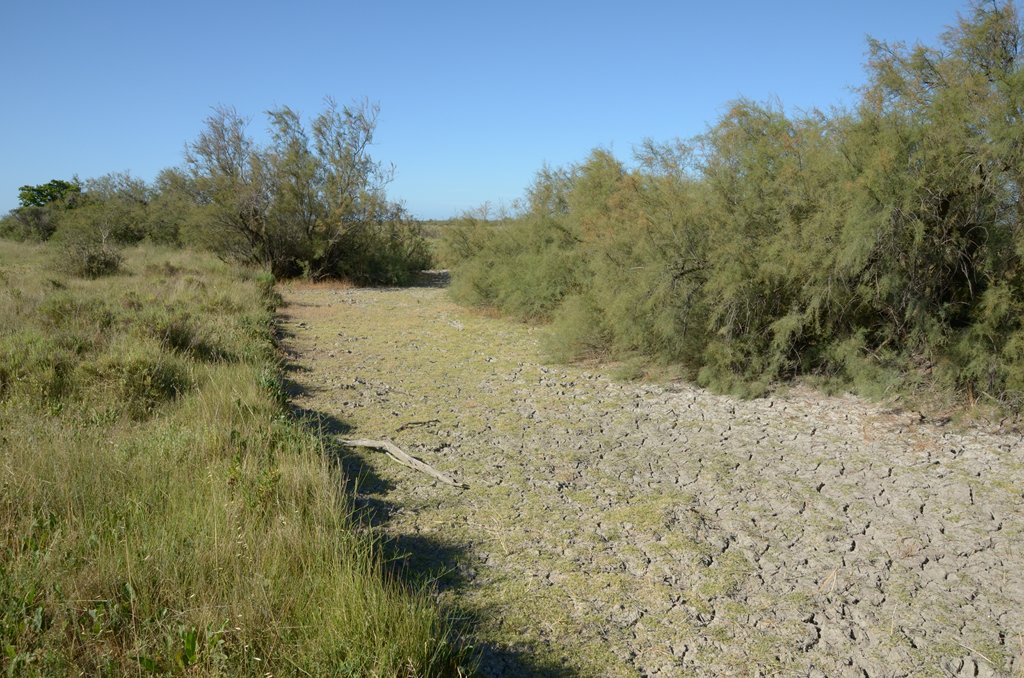A remarkable site for temporary ponds
The Tour du Valat Foundation is the owner of a 2560 ha estate made up of natural and agricultural lands, grazed by some 450 Camargue cattle and 80 Camargue horses. The natural zones form a mosaic of the emblematic and now rare habitats of the fluviolacustrine Camargue, the area at the interface between riverine and maritime influences.
 Parched temporary pond in summer on the Tour du Valat Reserve
Parched temporary pond in summer on the Tour du Valat ReserveIn particular, there is a wide diversity of plant species, certain of which are highly threatened. Among the eleven protected species (four at national level, and seven at regional level) found in the Tour du Valat RNR, two are of major importance for conservation:
- The Starfruit or Water star (Damasonium polyspermum) is an attractive little white-flowered annual plant, a member of the Alismataceae family. This Western Mediterranean endemic is typical of Mediterranean temporary ponds. Its world conservation status is listed as Vulnerable by the International Union for the Conservation of Nature (IUCN), and it is protected by ministerial decree in France, where it is present at some ten sites, including the Tour du Valat. In the RNR, it is found, sometimes in populations of several thousands, in six oligosaline (very slightly salty) ponds with a sunny exposition and scattered emergent vegetation; it emerges only when flooding conditions are favourable, i.e. when there is enough water in early spring.
- Riella helicophylla is a small aquatic liverwort just a few centimetres in height. Endemic to the Mediterranean basin, it is listed in Annex II of the Habitats Directive, and is currently being added to the list of French protected species. It is fond of distinctly saline, shallow, clear, temporary flood water, with limited plant cover. It was only recently discovered at the Tour du Valat (March 2012) in saline borrow pits and some low depressions in the flooded sansouïres bordering the Baisse Salée and the Saline ponds, covering at least 1.2 ha. Until then, it had only been found at one (former) site in the Hérault Department, and at Salin du Caban, east of the Rhone, one of the largest known populations of the species.
In terms of animals, the temporary ponds are also of primordial interest, for branchiopod crustaceans, odonates (dragonflies and damselflies), and amphibians. In wet springs, they literally teem with animals of kinds: from Triops cancriformis, a real living fossil, to the impressive tadpoles of the Common parsley frog or the Mediterranean/stripeless tree frog, and larvae of Zygoptera (damselflies, close relatives of the dragonflies). In this category, one of the commonest species in the Tour du Valat ponds, although highly threatened in France, is the Dark emerald damselfly or Dark spreadwing (Lestes macrostigma). This attractive damselfly, listed as Vulnerable in Europe by the IUCN, is only found in a few sites in France, along the Atlantic coast, in Corsica, and in the Camargue.
To conserve this natural heritage, it is necessary to maintain the natural hydrological regime of these ponds, characterised by their isolation and long completely parched periods in the summer. Their appearance thus varies immensely in function of precipitation level, ranging from bare cracked soil in late summer to vast flooded areas in wet springs, verdant and teeming with life.
*Habitat type 3170 in the Habitats Directive n° 3170.
Find out more:
Bigot L. 1999 Sur la réponse de Damasonium polyspermum Cosson (Alismataceae) aux variations des conditions édaphoclimatiques, d’après un suivi de 43 ans (1954-1996) dans une mare temporaire de la Tour-du- Valat (Camargue, Bouches-du-Rhône, France). Bull Soc Linn Provence 50 : 83-88 (in French)